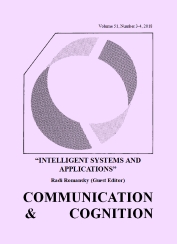|
INTO THE ORIGINS OF THE INSIDE – OUTSIDE DEBATE: REDISCOVERING SMELL/ODOR AND TRACKING THE STEPS OF NIETZSCHE, PROUST AND TIMOTHY MORTON
Wilfried Allaerts
Abstract
The philosophical problem of the Inside - Outside duality has a long history. In this paper I recall that not only this duality caught the attention of philosophers like F. Nietzsche, G.W.F. Hegel and J.-P. Sartre, but it also formed the pièce de résistance in the famous controversy between S.A. Kierkegaard and Th.W. Adorno. In Nietzsche’s early work Menschliches, allzumenschliches (1878), an interesting starting point is found that reminded me of the also famous, original viewpoint of M. Proust as expressed in À la Recherche du Temps Perdu (1914). Doing so, these re-collections brought me to a re-formulation of my 1992 paper on the problem of the linearity of written language and the nature of communication. This paper aims at showing that the translation of the Inside-Outside duality in a contemporary context together with a non-linear topography of natural communication, allows us to answer T. Morton’s (2016) challenging logic of the hyper-real and so-called agrilogistics view on ecology. It is concluded that this debate is indeed important to distillate a logic of future coexistence.
|
|
STORY TELLING USING ICONS OR GRAPHICS
Leon J.M. Rothkrantz and Siska Fitrianie
Abstract
Many stories in the mind of people are based on real life experiences or based, on stories told by others or stories from books, movies, dreams. A fascinating aspect of a good story is that it allows the reader to immerse in the story by playing the role of one of the characters. As a consequence, the story should be close to real life. However, some stories are based on the phantasy of the author. Usually stories are written in words. In this paper is shown that stories can be told using icons and graphics. In this paper a special crisis language will be described, designed for flooding crisis situation. The icons are easy to learn and to interpret. Icons are universal and independent of specific languages. Crisis situations and crisis actions can be described using the crisis icon language. In the paper stories based on icons will be described. In experiments is demonstrated that stories written in icons can be translated to similar text stories. The results indicated that the awareness of crisis and crisis events increases. The icon language is easy to download on a smart phone and can be used in flooding crisis situations.
|
|
HARMONY, CONFLICT, VERSUS COMMUNICATION, COGNITION, DECOMMUNICATION AND DECOGNITION
Wang Lin, Balder M, Vandamme F.
Abstract
Harmony, conflicts are basic issues of individuals as well as of local and international communities. They have important impact on the constructive as well as the destructive cognitive and communicative developments. They are also responsible for the cultural “decognition” and “decommunication”: the inactivating, the paralyzing, the decomposition, the destruction of the cognitive and communicative skills that is fast impacting all levels of society: youth, adults, seniors as well as nestors through between others the “ social media”. The basic cultural challenges, restrictions as well as dispositions are studied from the harmony as well as conflict (war) perspectives. This study starts on the basis of series of international as well as intercultural gnosts.
|



